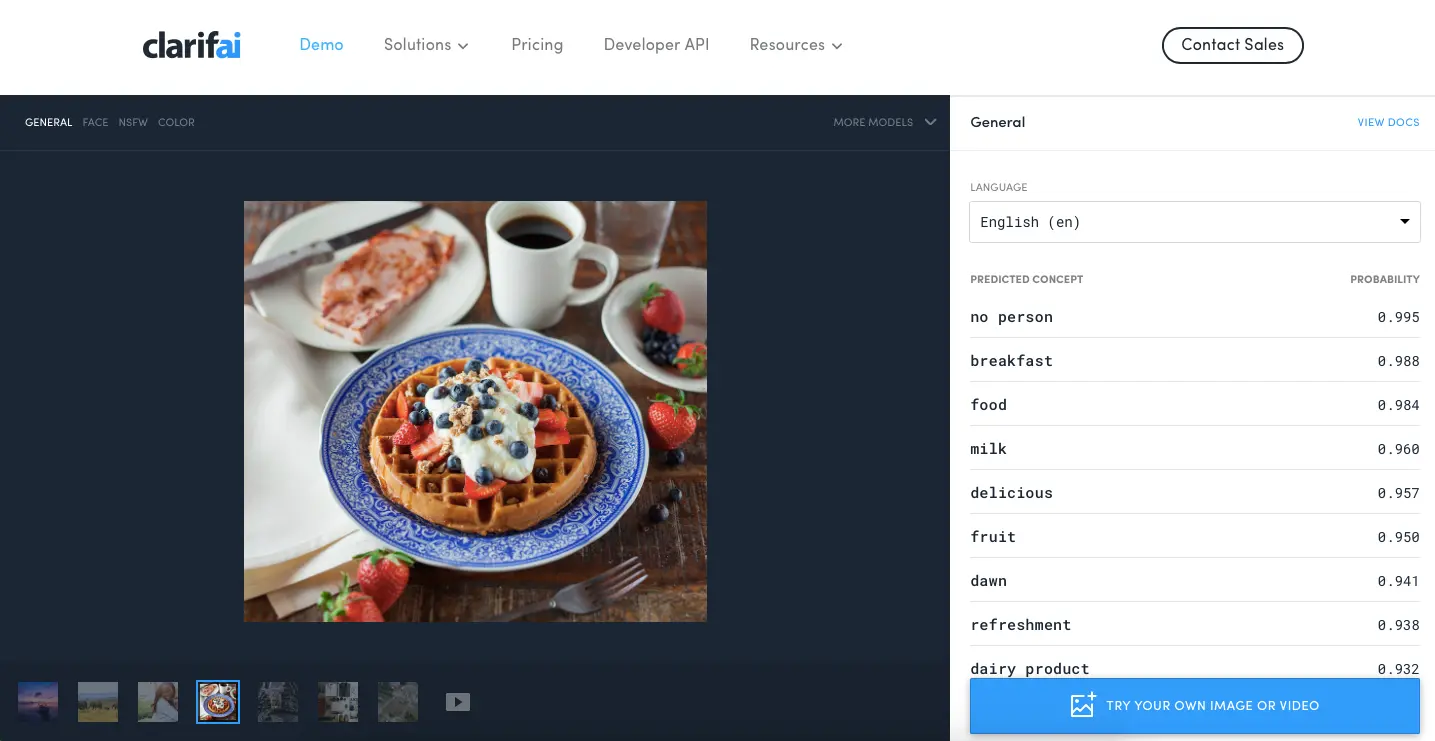 elements appropriately and helping brands streamline visual search, as well as personalize recommendations and moderate content.
elements appropriately and helping brands streamline visual search, as well as personalize recommendations and moderate content.
We spoke with Kristin Shevis (@SheviNY), the company’s chief customer officer, to get the scoop on how the tool works—and how brands can use it.
In a single sentence or statement, describe Clarifai.
Clarifai is a market leader in visual recognition technology, built on advanced machine learning systems and accessible by an API that’s used by companies like OpenTable, Trivago, West Elm and many others to improve the customer experience.
How does Clarifai use artificial intelligence (i.e. machine learning, natural language generation, natural language processing, deep learning, etc.)?
Clarifai lets computers see. For the first time you can send visual content and computers can understand it, enabling a whole new way of programming. Similar to how the brain works, it is built in many layers of processing. The first layer takes in pictures of the image and the last layer predicts the categories you care about within the images (such as if a photo includes “food,” or even more specifically, “pizza”).
What do you see as the limitations of artificial intelligence as it exists today?
Artificial intelligence requires data to work. For certain use cases, having quality data and understanding how to train the algorithms could be a limitation. At Clarifai, our Data Strategy team helps large companies with cleaning and sourcing data, as well as training the models in order to get the most benefit from the technology. The other main consideration is around data privacy, especially in working with tech giants (Google, Facebook, etc.) who are entering all sorts of side businesses competitive to their customer base.
What do you see as the future potential of artificial intelligence in marketing and sales?
The future is exciting on both the product and commercial growth front for Clarifai.
With our product, we’re continuing to innovate the platform and working closely with more brands to help them better serve their customers through visual search, the ability to personalize recommendations, and improved moderation. Our solutions will focus on revenue optimization and security monitoring and supervision.
We also recently launched our new Mobile SDK which allows you to run machine learning (both inference and training!) directly on device. While the immediate and obvious benefit of our Mobile SDK is the ability to run machine learning offline with very low latency, the thing we’re most excited about is enabling every device in the world to create a distributed training network that teaches AI using the collective knowledge of humans across the globe.
We’ve also released 15 new pre-built visual recognition models for specific use cases: celebrity recognition, demographics, NSFW, moderation, apparel, face detection, etc. and have plans to continue to make more available.
In 2018, we’re looking forward to expanding our offering even further across more devices like Android and IoT and of course providing even more models and innovation across new categories of recognition.
On the commercial side, we’re going to grow our company even more - we’re hiring right now! We are also looking at expanding our offices internationally.
What makes Clarifai different than competing or traditional solutions?
There are 3 things that set us apart:
One is focus. We’re solely focused on visual recognition and have been doing it longer than others, which gives us a competitive advantage in terms of speed of innovation. Some examples include being first to launch a Mobile SDK that allows training a model on-device without internet connectivity. Being first to launch support of video and staying ahead of the competition for custom training. Furthermore our CEO, Matt Zeiler, and members of our research team are renowned experts in this space.
Independence and trust is another. We’re focused on solving business problems and making products that developers love. We’re don’t have ulterior motives to sell online ads, web services, or professional services. Furthermore, we are not building other businesses that will compete with our customers in retail, entertainment, pharmacy, and health care to name a few. Customers can trust that their data becoming part of our data network will benefit them and they will benefit from other customers data without fear of building products that will literally compete with them.
Third, we’re business solution focused: the big tech giants offer competing general models, but businesses need custom solutions and Clarifai has expertise in building models that solve business problems. The tech giants are largely self-service offerings in visual AI with the end goal of selling computing power on their underlying cloud platforms.
Who are your prototype customers in terms of company size and industries?
The vertical where we’ve worked the most is retail, specifically in helping online marketplaces scale their businesses via leveraging our technology to organize, moderate content and in turn to personalize the experience for customers. Moving forward, we see huge benefits in helping retailers provide a true omnichannel experience to serve customers, which will impact revenue since a customer that shops on more than one channel buys five times as much as a single channel customer.
We also make the experience more personal. For brands, AI allows them to serve more targeted product recommendations to their users. AI helps analyze the nitty-gritty of a user’s likes, dislikes, and interests and what has historically been appealing to them and content they’ve engaged with.
For instance, Trivago presents content in their search results which reflects an understanding of a user’s preferences based on past activity.
In the case of our work with West Elm and their Pinterest Style Finder, our AI can help users search West Elm to find products that best match their inspirations on Pinterest with an added benefit for West Elm of potentially increasing customer basket size and customer loyalty.
What are the primary use cases of Clarifai for marketers and sales professionals?
Our solutions fall into two primary categories. The first is profit maximization. Use cases include content management and curation, customer analytics, visual search, and personal recommendations. The second is security monitoring and supervision, which includes content moderation and surveillance solutions, both of which yield operational efficiencies and improvement in customer experience.
Any other thoughts on AI in marketing, or advice for marketers who are just starting to explore the possibilities of AI?
If you have a lot of visual content, especially user generated content, AI can help with operational efficiencies and ultimately result in better customer experience via personalization and improved sales. Furthermore, unless you are an AI company, you should pick a trusted partner to help you scale your efforts, vs. trying to build in-house on your own.
Paul Roetzer
Paul Roetzer is founder and CEO of Marketing AI Institute. He is the author of Marketing Artificial Intelligence (Matt Holt Books, 2022) The Marketing Performance Blueprint (Wiley, 2014) and The Marketing Agency Blueprint (Wiley, 2012); and creator of the Marketing AI Conference (MAICON).



